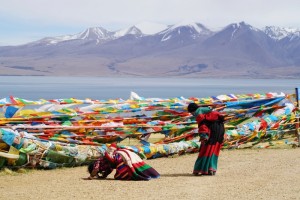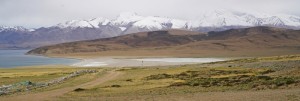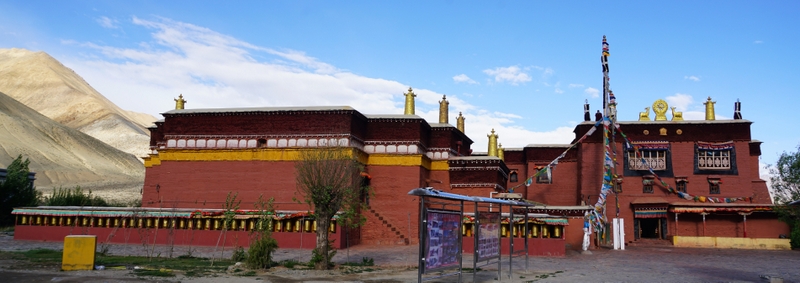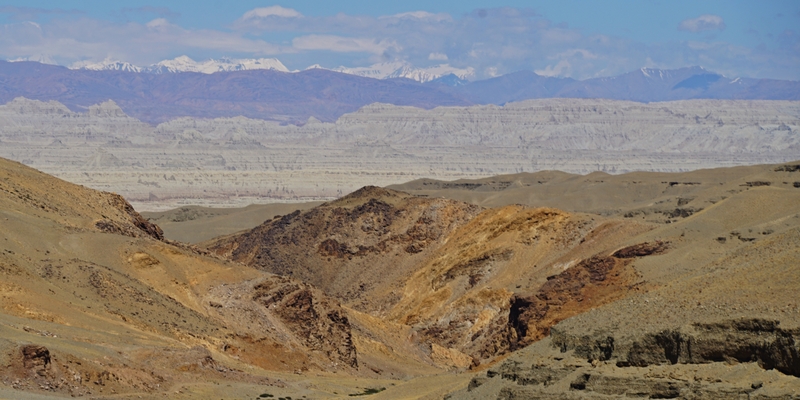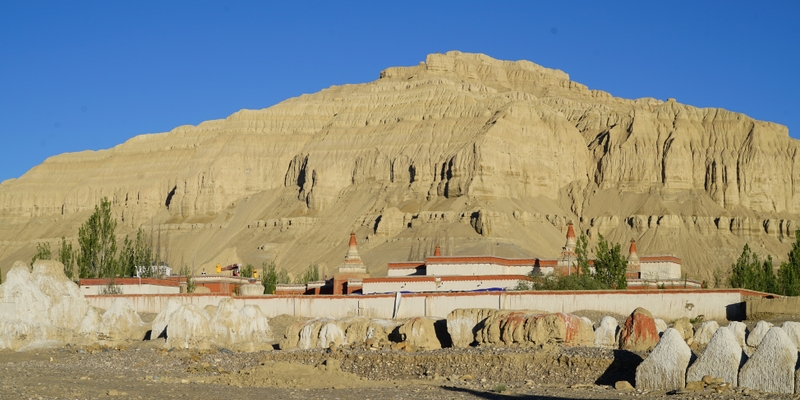15-day Circuit: Lhasa to Zanda: June 4 – 10, 2017
The Itinerary
![tibet-political-map[1]](http://www.sarahontheroad.hk/wp-content/uploads/2017/06/tibet-political-map11-300x186.jpg) There are seven prefectures地區in the Tibet Autonomous Region, namely Lhasa, Nagqu, Ngari, Nyingchi, Qamdo, Shannan and Shigaze. In 2011, Brenda and I hired a driver and planned to travel west from Lhasa to Ngari viaShigaze and return to Lhasa through the Nagqu prefecture (i.e. the west-north circuit). We travelled along National Highway 318 and then 219 visiting main cities, towns and attractions including Shigaze, Sakya, Saga, Darchen Mt Kailash (Holy Mountain), Lake Manasarovar (Holy Lake) and Zanda before arriving at Gar (Shiquanhe)in Ngari. As our driver refused to take the dirt road in the northern part of Ngari and Nagqu prefectures, we had to abandon our plan and took the same route back to Lhasa.
There are seven prefectures地區in the Tibet Autonomous Region, namely Lhasa, Nagqu, Ngari, Nyingchi, Qamdo, Shannan and Shigaze. In 2011, Brenda and I hired a driver and planned to travel west from Lhasa to Ngari viaShigaze and return to Lhasa through the Nagqu prefecture (i.e. the west-north circuit). We travelled along National Highway 318 and then 219 visiting main cities, towns and attractions including Shigaze, Sakya, Saga, Darchen Mt Kailash (Holy Mountain), Lake Manasarovar (Holy Lake) and Zanda before arriving at Gar (Shiquanhe)in Ngari. As our driver refused to take the dirt road in the northern part of Ngari and Nagqu prefectures, we had to abandon our plan and took the same route back to Lhasa.
Brenda and I are keen to see the less-travelled northern part of Xizang which has become more popular since our last visit in 2011. This time, Brenda has managed to find an agent that can provide two experienced Tibetan drivers. While the itinerary for the first seven days would take me back to places I have visited before, the route beyond Gar on Day 8 would be new. Hence, I would not detail the places I have already covered in the 2011 travel notes unless there are things of note.
Day 1 Sunday: Lhasa – Shigaze日喀则(350km)
We set off shortly after 8am. I was in a 4X4 with SK, Winnie and our driver was Bianba 邊巴. Brenda, Kai and Kylie were with Zangpo. We followed the National Road318 (from Shanghai to Zhangmu 樟木 at the border with Nepal). On the way, we passed Yamdrok Yumtso 羊卓雍错(4488m), one of the three holy lakes in Xizang. Though this’s already my third visit, I still enjoy the sight of this stunning turquoise lake especially in a clear day with snow-cladded mountains in the background.
Things have changed since my last visit in 2011. This scenic area has become touristy: visitors are required to pay an entrance fee of RMB40 (people between 60 and 70 can get a half price ticket). Most of the photo spots are now lined with locals selling souvenirs or demanding visitors to pay to take photos with their dogs in front of the landmark. What a shame!
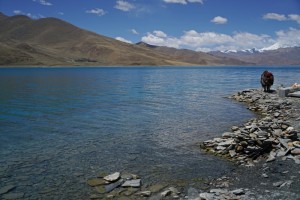 |
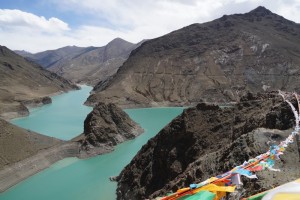 |
We stopped at Langkatze浪卡子, an ancient trading post for lunch. Then we proceeded to the picturesque Manga Reservoir 满拉水库 with a ruin standing in the water. The prayer flags add so much life and colours to the area!
We saw a hanging glacier 卞若拉冰川by the roadside before proceeding to Gyantse江孜城 the famous battle ground where a combined Tibetan and Chinese army drove back troops of the Gorkha Kingdom in late 1790s.
At 5:45pm, we arrived at Pelkhor Chode Monastery白居寺. As Brenda and I had already visited it in 2011, we spent an hour discovering the area around the monastery. First, I climbed the hill next to the monastery for a panoramic view of the monastery and the surrounding area. This is the first time I can see the entire monastery.
Brenda and I then discovered the old street of Jiarijiao behind the new street that leads to the monastery. It’s atmospheric with traditional houses lining both side of the street and animals kept outside the house. This street used to be the collection, distribution and trading centre of old Xizang frequented by traders from Xizang, Nepal and India. The building used to be the Nepal House still stands. At the end of the street is the hill where the fortress perch at the top.
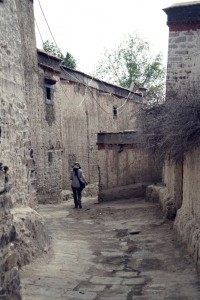 |
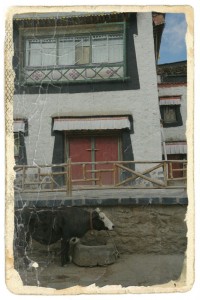 |
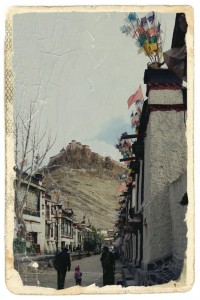 |
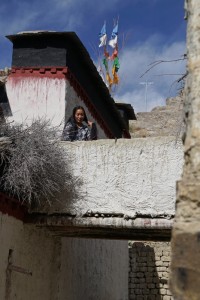 |
We finally arrived at Shigaze(3860m) the second largest city in Xizang after 8pm. After a good meal with mutton, chicken and vegetables, we were taken to the Shigaze KD Manasarovar Hotel (RMB280 for a double). As I was still coughing badly, I decided to go to a local pharmacy and got four different types of medication for RMB56. Would it work? I am not sure! Brenda was my room mate and I worried I would be a nuisance.
Day 2 Monday: Shigaze- Sakya薩迦(150km)
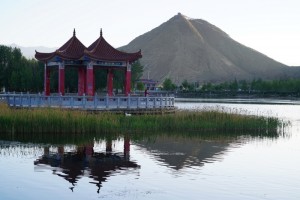 Shigase has grown a lot since my last visit in 2011. The regular train service from Lhasa to Shigase which began running in August 2014 has contributed to its economic development: there are more hotels, shops and eateries. I had a better sleep and woke up around 6am. I took a walk around the newly built city park near the hotel and saw many early risers in the park.
Shigase has grown a lot since my last visit in 2011. The regular train service from Lhasa to Shigase which began running in August 2014 has contributed to its economic development: there are more hotels, shops and eateries. I had a better sleep and woke up around 6am. I took a walk around the newly built city park near the hotel and saw many early risers in the park.
I returned to the hotel for breakfast at 8am. After drinking some lukewarm butter tea, I started to have problem with my stomach. A sign of trouble!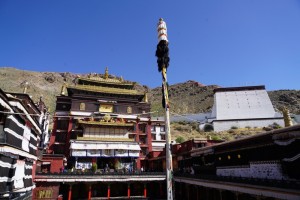
We went to Tashilhunpo Monastery 扎布倫寺covering an area of 700,000m². Founded in 1447 by the 1st Dalai Lama, it is the traditional seat of Panchen Lama班襌, the second highest ranking tulku lineage in the Gelugpa tradition of Tibetan Buddhism. Though I visited it during my first visit in the 1990s with a guide, I enjoy my second visit without a guide even more! I strolled around at my leisure, soaking in the atmosphere and exploring numerous halls and narrow alleys between high walls, like Alice in Wonderland.
I followed the visitors’ path climbing countless flights of staircases to look at the major halls/temples. I recall some of the halls I had visited before. With more information on Tibetan Buddhism, I can better appreciate the architectural styles of the buildings, countless images, murals and statutes in the Maitreya Temple (the tallest building of the monastery with the world’s largest gold-gilded bronze statute of the future Maitreya), Gudong (the old living quarters of the Panchen Lama), the main Chanting Hall, the Sutra Hall, the Great Courtyard, the great flag-stoned courtyard and numerous chapels located on two-tiered levels of the Roof Chapels (housing reliquary chapels of previous successive Pachen Lamas).
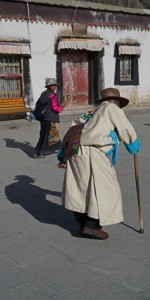 |
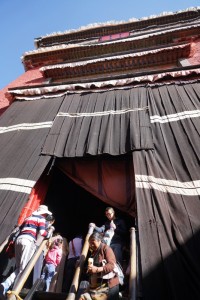 |
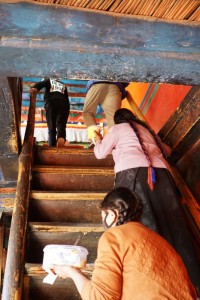 |
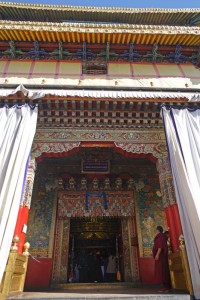 |
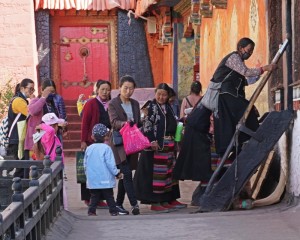 |
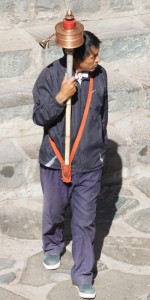 |
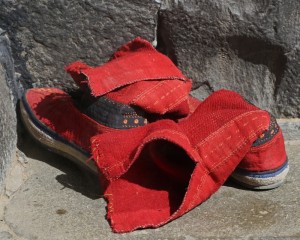 |
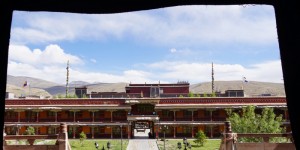 It is impossible to see the monastery in two hours. If I ever return for the third time, I must set aside half a day to explore it and walk around the complex. We left Shigaze for Sayka, a monastic town and reached it before lunch. Dominated by a monastery complex, Sayka is the seat of the Sakyapa school of Tibetan Buddhism 萨迦派. The complex is divided into two parts: the North Monastery 北寺 was established by Khon Konchok Gyalpo in 1073 while the south one was set up by Sakya Sangpo in 1268.
It is impossible to see the monastery in two hours. If I ever return for the third time, I must set aside half a day to explore it and walk around the complex. We left Shigaze for Sayka, a monastic town and reached it before lunch. Dominated by a monastery complex, Sayka is the seat of the Sakyapa school of Tibetan Buddhism 萨迦派. The complex is divided into two parts: the North Monastery 北寺 was established by Khon Konchok Gyalpo in 1073 while the south one was set up by Sakya Sangpo in 1268.
As Brenda and I have visited the fortress-like South Monastery before, we decided to ask Bianba to take us to see the hermitage 开悟寺 nearby. But as Brenda did not feel, she took a rest while I went on my own. I am surprised to find the narrow 19-km path well paved. I still remember the stone huts at the end of the road: they look smart and prosperous now. I think an attempt has been made to turn one of the hot springs into commercial use with a pool built outdoor. But the windows are broken and the water in the pool looks murky. What a shame!
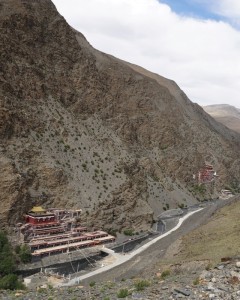 |
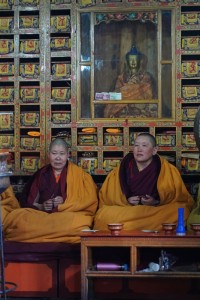 |
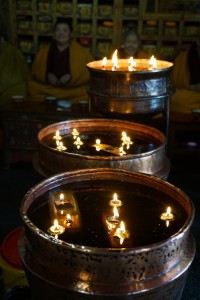 |
I was back in town by 5:15pm. As it was early, I walked along the hillside visiting the college with some 100 students. I watched them debating in the garden (which appears like combat and play to an outsider).
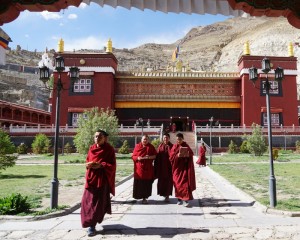 |
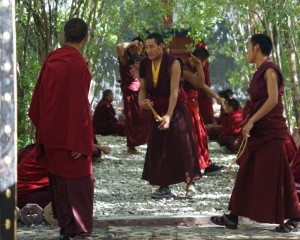 |
I followed a path uphill and soon reached a few white stupas (I was here in 2011) with panoramic views of the town below.
I soon met a G-Adventure group with seven members coming from America, Australia, Canada and the UK. The Indian guy from the UK was suffering from severe altitude sickness: he had to rest several times before reaching a nunnery at the eastern end of the trail. He then dropped to the ground and rest for some ten minutes. He planned to go to Qomolangma Base Camp and take on the 3-day Mt Kailash kora. Given his condition, his guide persuaded him to take a donkey for the kora as he would be too weak to walk.
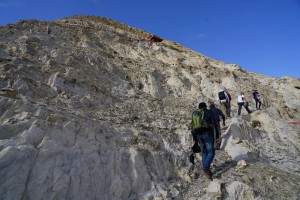 |
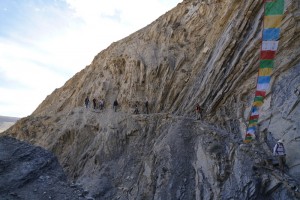 |
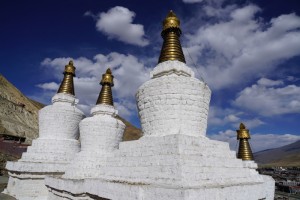 |
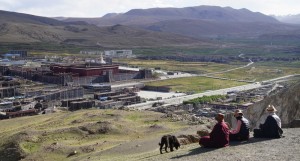 |
I joined the group and went into the nunnery where we spent half an hour. Some nuns were chanting while a few tried to communicate with us using hand signs. I sat with two cheerful nuns. It’s a pity that I could not talk with them.
I had problem since taking a butter tea in the morning. My stomach was not functioning: I did not feel hungry. I feared I might have a problem. I did not join my friends for dinner at 7pm. Kylie later gave me a bowl of hot sweet potato soup and mint tea. I went to bed early and hoped to feel well soon. We stayed in a hotel next to the one we stayed last time for RMB280 a night for a double.
Day 3 Tuesday: Sakya – Baiba 白坝(150km)
When I got up around 7am, I felt unwell and tired. Before leaving the hotel, I vomited several times throwing up the food I had yesterday. I felt better though.
Today’s plan was to go to Qomolangma Base Camp珠峯大本营(5200m). Brenda would not go owing to her problem with altitude. Originally I planned to revisit the base camp and try to walk to about 5600m. But as I was not in top form, I decided not to go as I must stay healthy for the next three weeks. Anyway, I had a nice close-up view of the world’s highest peak in 2011.
We left Sakya shortly after 9am and arrived in Baiba (4320m), a small town for an early lunch shortly after 11am. When I saw a clinic/hospital opposite the restaurant, I decided to consult a doctor to check my blood pressure, pulse and lung (as I had been coughing for a week). It’s a new building which is already in a poor state. I found two young Tibetan doctors in a large consultation room. One checked my breathing while the other took my blood pressure (120/90) and pulse. They were all within normal range. Anyway, the doctor knowing my problem with my stomach and bad cough, gave me a prescription. I spent RMB6 on two types of pills!
Bianba dropped Brenda and I in the best hotel in the area. The room was descent (by the local standard) and we spent the whole afternoon chatting and resting. We did not go out to eat and I slept from 8pm to about 7am the following day. A rest day which I badly needed!
Day 4 Thursday: Baiba – Saga薩嘎(280km)
I woke up with a slight headache owing to over-sleeping. Not a big problem! I had a light breakfast (congee and a steam bun). While waiting for Bianba to pick us up, I spent my time on my travel notes. Bianba arrived around 10:45am and we soon met up with our friends near Xegar-Zhen where the road to the base camp branches off from National Highway 318. They had spent a night in a tent at the Base Camp. They said it was cold, windy and cloudy the day before. They only had good views of the world’s highest peak in the morning. I must have been lucky as I had seen the peak both at sunset and sunrise in 2011.
We had an early lunch at Old Tingri 定日 where I could see the majestic Cho Oyu 卓奧友峯 (8188m), the world’s 6th highest peak, from the roadside. National Highway 318 heads turns south towards Nepal soon after leaving Mainpu. At this junction, we took the road westward heading to Pelkutso 佩枯措 (4591m). We drove next to the Shishapangma希夏邦马 Range with the tallest peak standing at 8027m, the world’s 14th highest peak which lies entirely within China. All in all, nine out of the world’s 14 mountain peaks over 8000m are in or on the border with China. I recalled seeing many wild asses in 2011. But this time, I did not see any possibly owing to increased traffic in the area.
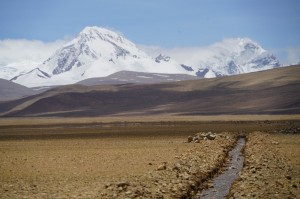 |
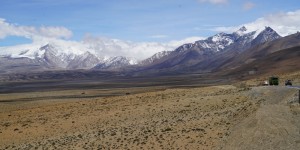 |
We had several photos stops along this road. Pelkutso looks prettier this time with blue sky (it was late when I got here in 2011).
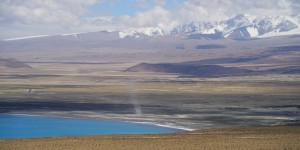 |
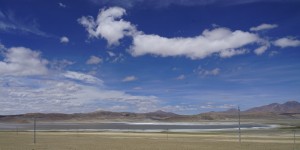 |
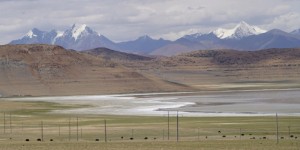 |
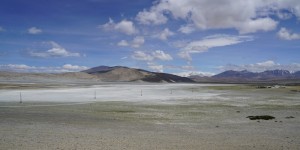 |
The road conditions have improved a lot and we cruised along. By 5pm, we arrived at Saga (4500m) and stayed in Saga Hotel where I stayed in 2011 (RMB280). I coughed less and had a reasonable sleep.
Day 5 Friday: Sa Ga – Purang 普兰 (560km)
As we would leave at 8am, Brenda set the alarm at 6:30am. We had an excellent breakfast with congee, steam bun and soya milk for RMB15pp. I prefer this typical type of breakfast which is often loathed by foreigners.
We followed National Highway 219 with both the Yarlung Zangbo River and the Himalayas to the south. We had a photo stop with the river and the snow-cladded mountains in the background. Here we met a group of 12 Hong Kong cultural tourists on their way to spend three days in Zanda. We stopped in Paryang-zhen 帕羊镇 (4610m) for lunch where I saw my friends from the G- Adventure again. The Indian guy looked better and they were heading to Darchen to begin the kora the day after. I wished him luck in completing the kora on donkey.
Soon after lunch, we entered the Ngari (or Ali) Prefecture. We were thrilled when Bainba pointed out a big group of Tibetan antelope on a ridge: a male was surrounded by over 80 female and young ones.
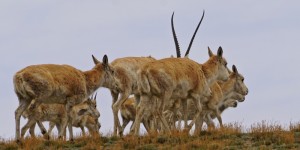 |
|
The weather was fantastic: we had the Gangdise Shan岡底斯山 on the right and the Himalayas on the left.
At Hor, we had our first view of Mt Kailash 冈仁波齐峰(6714m) when standing on the shore of Mapam Yumtso 玛旁雍措湖. The holy mountain and Lake are associated with Buddhism, Hinduism and Bon. We were lucky!
We left National Highway 219 at Bagag 巴葛and turned south driving 104km on Road 207 to Purang (3700m). Now, we had the Mapam Yumtso (4588m) on the left and the La’ngatso 拉昂措(4573m) (Ghost Lake鬼湖) on the right. Given the fine weather, the Ghost Lake surrounded by mountains looks charming with a mirror-like turquoise surface.
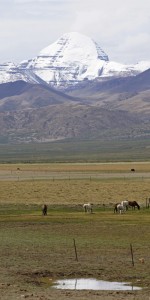 |
|
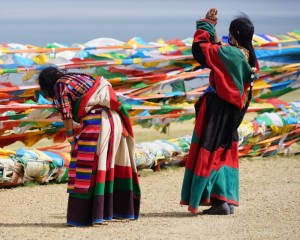 |
After driving about 100km, we arrived at Purang, a picturesque town lying between two mountain ranges with the Peacock River 孔雀河flowing through it (This river flows to Nepal). We had some difficulties in finding our hotel as there are three hotels with the same name. Finally, we checked in the Himalaya Purang Hotel after 7pm (RMB360 for a double). Though the hotel looks new, the condition and quality are far from satisfactory as a 4-star hotel. We were hungry and tired and went to a local eatery nearby. But we had to wait over an hour for a simple dinner. It was after 9pm when we got back to the hotel. Luckily, I coughed less and had a good sleep.
Day 6 Saturday: Purang – Korqia 科加 – Darchen塔钦(150km)
We had breakfast at 8am and departed for Korqia 科迦 at 9am. After driving 18km, we arrived at Korqia Monastery 科加如意寺 (3670m). It is an important monastery built in 966 AD by Rinchen Sangpo 仁靑桑布 who was a great Buddhist monk and translator who played an important role in reviving Buddhism in Xizang. There are three statues of Manjushri made of silver.
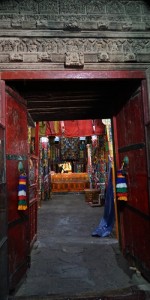 |
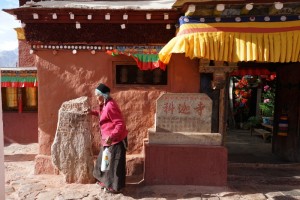 |
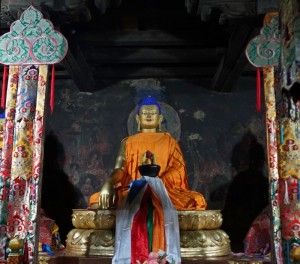 |
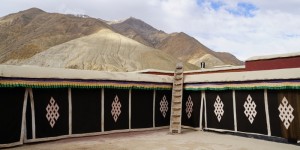 |
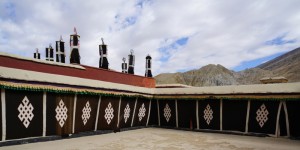 |
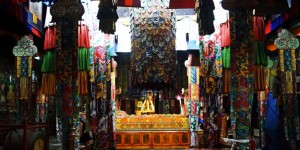 |
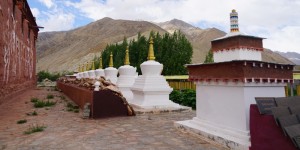 |
We met the cultural group from Hong Kong again. They were guided by an archaeological professor and I followed them for a while and appreciated the amazing mural paintings and wood carvings. I climbed to the top level which affords fantastic views of the valley and the monastery. A most enjoyable visit!
We followed the same road back to National Highway 219 with two photo stops at La’ngatso which looks amazingly beautiful. Last time, it looked dark and evil especially when our vehicle got stuck in the sand after he attempted to take (or rather steal) money placed in a pile of stones on the beach. We had to pay a garage to rescue us at the end! But today, though we could not see Mt Kailash from here, the lake looks serene and calm.
We arrived at Darchen (4575m) shortly after 1pm and had lunch before checking in Himalaya Darchen Hotel run by the same group as Himalaya Purang Hotel(RMB380 for a double). Things are expensive here: a decent simple lunch with dumplings, noodles, vegetables and mutton cost RMB350.
The weather was fairly good and we could see the top of Mt Kailash from the main street. As I did the kora in 2011 and my friends had no plan for it, we only spent a day in Darchen. After lunch, we had a short hike up the hill behind the town which affords a panoramic view of the surrounding areas including the Ghost Lake. Brenda who was affected by the altitude, took a rest in the afternoon.
We had dinner in the same restaurant as the chef was able to cook to our requirement i.e. little salt and oil and no MSG. We had an early night.
Day 7 Saturday: Darchen – Zanda 扎达(250km)
We set off at 9am and had one of the most scenic rides of the trip. It was freezing and windy and the sky was clear and blue. Recent snow falls had added a white veil over some of the mountain tops. I therefore found the scenery and landscape even more impressive as the white snow had brought out the contrast of colours even more.
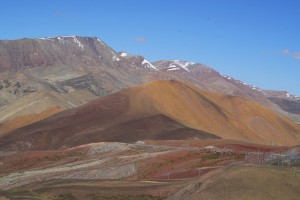 |
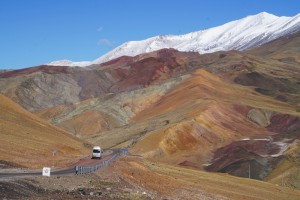 |
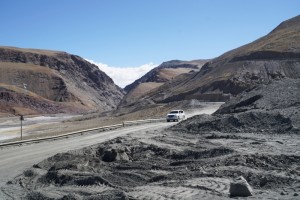 |
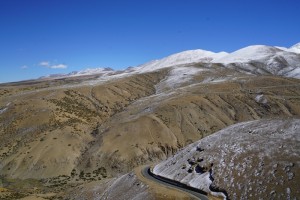 |
Brenda and I took exactly the same route as in 2011. We continued to drive on National Highway 219 till we turned south following a well-paved 174-km road to Zanda. On the way, we passed through the famous Zanda ‘earth forest’ 土林 which is now a national geopark with an area of 2464km². A variety of earth forests stretches for some 100km with altitude varying from 3750 to 4450m. We stopped at a viewing platform for panoramic views of the expansive canyon with the Himalayas as the backdrop. I find the landscape as stunning as ever.
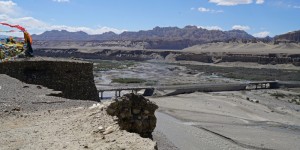 Around 2pm, we arrived at Zanda (3700m)located next to theXiangquan River 象泉河(which flows to Ladakh). The town has grown a lot since 2011 and we stayed in a comfortable 4-star Castle Hotel (RMB460 for a double). We were lucky in finding a Sichuan restaurant which has an excellent chef who does not spoilt food with excess oil, salt and MSG. We ordered a whole chicken, and three vegetable dishes for RMB260. This was the best meal we had so far.
Around 2pm, we arrived at Zanda (3700m)located next to theXiangquan River 象泉河(which flows to Ladakh). The town has grown a lot since 2011 and we stayed in a comfortable 4-star Castle Hotel (RMB460 for a double). We were lucky in finding a Sichuan restaurant which has an excellent chef who does not spoilt food with excess oil, salt and MSG. We ordered a whole chicken, and three vegetable dishes for RMB260. This was the best meal we had so far.
Our drivers had to register our details with the local police and the group did not set off for the ruins of the ancient Guge kingdom located some 18km away till 4:30pm, I did not join them: I prefer to spend time wandering aimlessly around this amazing religious site centering around the Tholing Monastery托林寺, with a group of 108 ancient stupas and countless colourful praying flags and Marnyi stones outside its walls.
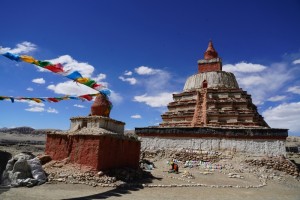 |
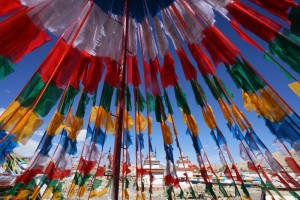 |
It is a timeless place. Standing at the edge of the plateau looking at the fading colours of the monastery and the ancient stupas, the slow-flowing river below and the expansive earth forest across the river, I am lost in time. I spent two hours soaking in the timeless atmosphere gazing at the monastery which is planked by barren brown mountains, looking at the earthly Buddha towers, ancient stupas and watched a few faithful pilgrims walking and praying with the praying wheel on my hand and beads on the others.
I met my friends again after 7pm and we went out for dinner in the same restaurant. Unfortunately I lost my red warm fleece jacket brought in Norway last year. I hope whoever took it would wear it as it would give him/her warmth. We returned to the same restaurant for dinner. This time, we had pork knuckle, pork with potato and two vegetable dishes for only RMB160. Excellent value!
After dinner, I returned to the edge of the plateau hoping to watch a nice sunset as in 2011. I hanged around till 9:30pm without seeing anything compared to the one I saw last time. That’s life!
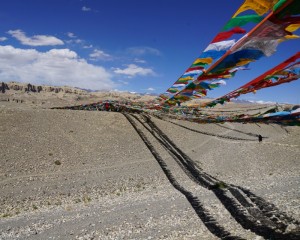 |
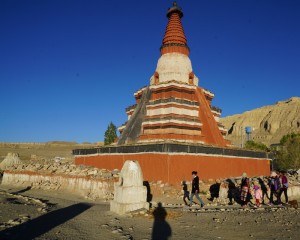 |
Zangpo was sick with fever and had problem with his stomach. He suspected his illness was caused by the tea-leave egg I bought him in Purang. We insisted he should rest and decided to start late the next day.



![tibet-road-map[1]](http://www.sarahontheroad.hk/wp-content/uploads/2017/06/tibet-road-map1.jpg)









